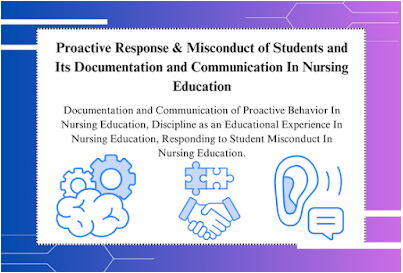The Proactive Response and Misconduct of Students and Its Documentation and Communication In Nursing Education. The results of this study showed that the top support challenges nursing students face in the clinical setting are violence, fear and anxiety, sociocultural challenges, environmental and organizational stress, and ineffective training.
The Proactive Response and Misconduct of Students and Its Documentation and Communication In Nursing Education
In nursing education, addressing student misconduct requires proactive action, thorough documentation, and clear communication to protect patients, maintain ethical standards, and ensure student success. Early intervention and clear communication are just as crucial as accurate and timely documentation of misconduct so that fair disciplinary action can be taken.
Despite all reservations, react to these situations as quickly as possible. This means stopping cheating during an exam (in which case, let the student finish the exam and talk to them later) or notifying the student as soon as you become aware of a potential violation.
Academic integrity is essential for several reasons: Trustworthiness: It promotes trust among students, faculty, and institutions. When academic integrity is maintained, those involved can trust the validity of academic work and transcripts. Equity: Ensures equal competitive conditions for all students.
Documentation and Communication In Nursing Education Effective documentation and communication of proactive behavior are crucial in nursing education. Faculty members need to meticulously record student behaviors, including those that might not immediately violate classroom standards or campus codes but could potentially escalate.
Why Documentation Matters
Maintaining detailed records helps faculty identify patterns of concerning behavior that might otherwise go unnoticed until they become significant issues. For instance, instead of general comments like “the student was rude,” precise documentation such as “the student arrived late to four of the last six classes, disrupting lectures” is more actionable and informative.
FERPA Compliance and Privacy Concerns
Understanding and adhering to FERPA (Family Educational Rights and Privacy Act) is essential. According to FERPA guidelines, faculty and staff can share information about students when there’s a legitimate educational interest, which includes matters related to classroom management and student conduct. This balance between privacy and institutional responsibility ensures both student rights and campus safety.
Best Practices for Documentation and Communication
- Record Specifics: Note the date, time, and exact nature of the observed behavior.
- Use Descriptive Language: Focus on factual descriptions rather than personal judgments.
- Communicate with Department Chairs: Keep relevant administrative figures informed of any concerns or documentation.
By following these best practices, faculty can effectively manage and address student behavior, ensuring a positive learning environment.
Discipline as an Educational Experience in Nursing Education
Discipline in nursing education is not just about enforcing rules; it’s a fundamental part of preparing students for their professional careers. Faculty should frame disciplinary actions within an educational context to help students understand the importance of adhering to standards.
The Role of Discipline in Education
Setting clear conduct standards teaches students about the professional expectations they will face in their careers. For example, punctuality and integrity in academic settings mirror the responsibilities and ethical standards expected in the workplace. By emphasizing these values, nursing students are better prepared for their future roles.
Educational Framework for Discipline
- Model Professionalism: Demonstrate the importance of arriving on time and maintaining academic integrity.
- Teach Consequences: Help students understand the impact of their actions on their learning and future professional behavior.
Incorporating discipline as a teaching tool not only addresses immediate behavioral issues but also contributes to long-term professional development.
Responding to Student Misconduct in Nursing Education
Addressing student misconduct in nursing education requires a systematic approach to ensure fair and effective resolution. Here’s a step-by-step guide to managing such issues:
1. Gather and Document Information
Collect objective information about the misconduct, including dates, times, and any witnesses. Accurate documentation provides a clear record of the incident.
2. Confront the Student
Meet privately with the student to discuss the observed behavior. This conversation should help the student understand how their actions affect the learning environment and offer them a chance to explain their perspective.
3. Focus on Behavior
Address the specific behaviors in question rather than personal attributes or academic performance. Consistent expectations for all students ensure fairness.
4. Outline Required Changes
Clearly communicate the necessary behavioral changes and work collaboratively with the student to address the issues. Document any violations and follow up as needed.
5. Explain Consequences
Make sure the student understands both the potential positive outcomes of compliance and the consequences of continued misconduct. This clarity helps in setting expectations and encouraging appropriate behavior.
6. Refer Complex Cases
If the situation does not improve or escalates, refer the case to additional campus resources for further intervention. This ensures that all necessary support and action are taken to resolve the issue effectively.
By following these steps, faculty can address student misconduct constructively, maintaining a supportive and effective learning environment.
Read More:
https://nurseseducator.com/didactic-and-dialectic-teaching-rationale-for-team-based-learning/
https://nurseseducator.com/high-fidelity-simulation-use-in-nursing-education/
First NCLEX Exam Center In Pakistan From Lahore (Mall of Lahore) to the Global Nursing
Categories of Journals: W, X, Y and Z Category Journal In Nursing Education
AI in Healthcare Content Creation: A Double-Edged Sword and Scary
Social Links:
https://www.facebook.com/nurseseducator/
https://www.instagram.com/nurseseducator/
https://www.pinterest.com/NursesEducator/
https://www.linkedin.com/in/nurseseducator/
https://www.researchgate.net/profile/Afza-Lal-Din
https://scholar.google.com/citations?hl=en&user=F0XY9vQAAAAJ
